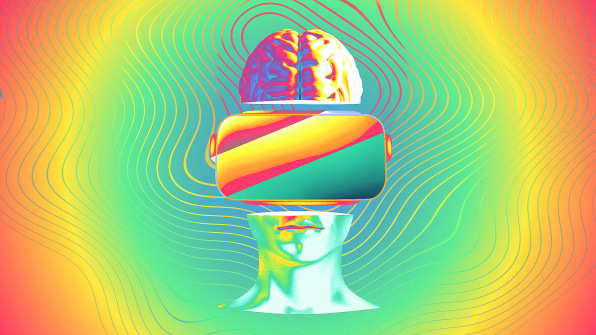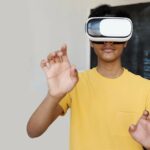A scientist just proved that virtual reality can induce powerful brain states for intelligence and health. Now he believes the (virtual) sky is the limit.
Virtual reality is fun. But what if it could be more than fun? What if VR could make you smarter?
For more than 70 years, scientists have known about a brain phenomenon called the “theta rhythm.” To oversimplify it, your brain thinks not just in frequencies but in syncopated beats. And the theta is the most prominent rhythm in the brain.
Theta rhythms are active when we’re awake, then increase when we walk. They disappear when we sleep but crop back up when we dream. In more than 70,000 studies and counting, theta rhythms have been shown to be critical in cognition, learning, and memory, and we see them go awry in maladies like Alzheimer’s disease, ADHD (attention deficit hyperactivity disorder), anxiety, and epilepsy.
For years, drugs have attempted to boost theta rhythms by attaching themselves to neurons in our brain, with varied success. But now, for the first time, scientists at the University of California, Los Angeles, have found a way to increase theta rhythms in mice simply by putting them inside a virtual reality simulation. Their findings were published in Nature Neuroscience.
UCLA professor Mayank Mehta, who led the research, believes that this breakthrough will allow VR to be used to revolutionize treatment for mental disorders, and could even be used to sharpen cognition to help people learn faster.
As for how and why it works?

“I’m scratching my head, seriously,” Mehta says with a laugh.
In truth, VR is already being used for all sorts of treatments, ranging from its clinical use for PTSD (post-traumatic stress disorder) to physical rehabilitation. We know that these headsets—for whatever mainstream market appeal that’s lacking—have proven to be an excellent way to re-create a certain sensation, or offer a particular stimulus, within the tight confines of hospital beds.
Mehta isn’t demonstrating that VR can have positive effects on the brain just because it feels like real life. He’s arguing that something within VR itself—or at least the VR system his lab has built for the mice he studies—can impact the brain at a deep, electrical level, which could impact treatment and learning separately, and on top of VR’s intense visual simulations.
Mehta is a physicist by training, but he has been studying the brain for nearly two decades. Much like light and sound waves across the universe are just harmonic frequencies playing out across space, so too is human thought powered by the oscillation of energy passing from neuron to neuron. He believed that, with this common entry point between physics and neuroscience, he could begin to deconstruct the mechanisms of the brain.
To unpack how the brain works, he began putting mice into extremely complex, tiny virtual reality rigs. What he learned quickly was that even his lab’s own VR system—which puts a mouse on a miniature treadmill surrounded by immersive screens—is not so real to the brain at a structural level. In 2013, he published his findings in Science: that up to 60% of the neurons in the hippocampus (known for learning and memory) shut off in VR.
Investigating the relationship between VR and the brain proved to be a deep well for research and a viable tool for unpacking the fundamentals of perception. Over the years the research continued, as his lab leveraged VR to unpack how the brain perceives space and time. Along the way, Mehta noticed a strange trend. Theta frequencies (the pitch of some thoughts, not their rhythmic beats) are routinely slower in VR than in the real world. Not a lot slower—we’re talking differences on the millisecond level—but they are slower.
That led to this latest study, in which Mehta’s lab discovered that mice experience boosted theta rhythms while in VR that they didn’t experience in the real world, even though the entire VR environment was meant to duplicate the mice’s real-world environment as closely as possible. Something about VR itself appears to be beneficial to human cognition. As for that one lingering question: How is this happening? “I think that was witchcraft in the brain, chaos,” he says. “[We have some] funky ideas. We are definitely spending a lot of effort [to figure it out].”
To Mehta, this could lead to a huge breakthrough in how we treat mental health and cognition, even though 60% of the neurons are still shutting down in the hippocampus in VR. As he explains, while it’s counterintuitive that fewer brain cells would make for a faster rhythm and stronger thought, the truth is that we know overactivity of the brain can impede thinking, and even cause problems like epilepsy. “A more active neuron is not necessarily better,” Mehta says. “The brain consumes one-third to one-fifth the energy of the rest of the body, so it tries to optimize.”
Is there some hidden cost to boosting your theta rhythms in VR? Mehta insists there aren’t, and also promises to release another paper in the coming weeks confirming that there are no measurable downsides.
“Now we want to take this to town, and potentially use this as a VR therapy,” Mehta says, noting that since human research is far more expensive than animal research, he is looking for funding and corporate partners to realize the work. He’s also open to testing third-party VR systems, like the Oculus Rift or HTC Vive, in the future.
“Fortunately, the way we developed VR, it can be readily used directly for humans,” Mehta says. “So we’re gearing up.”
Quelle:
Foto: [Source Images: koya79/iStock, iStock]
https://www.fastcompany.com/90651249/how-vr-could-make-you-smarter


